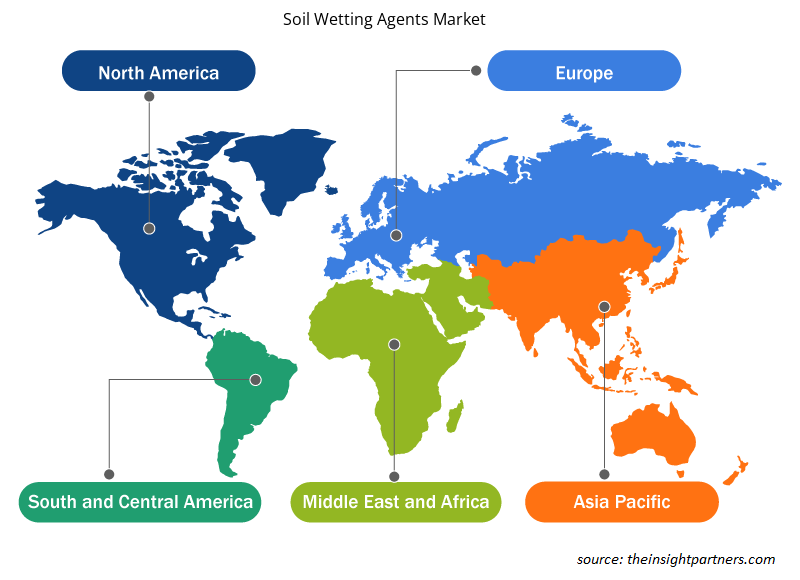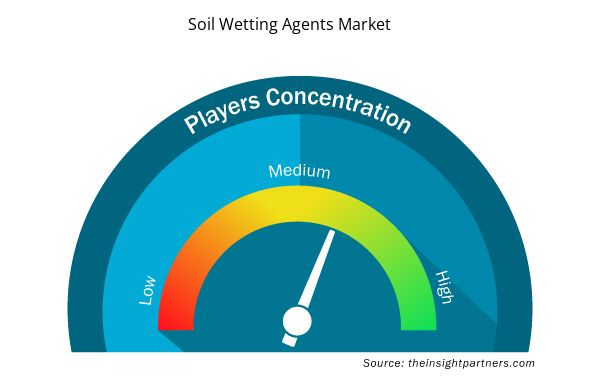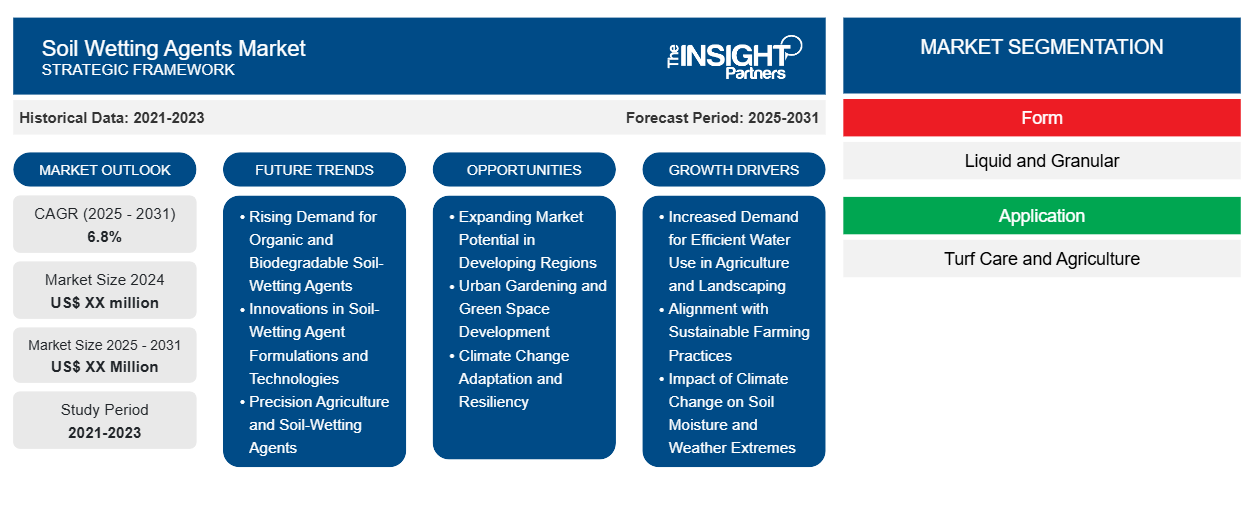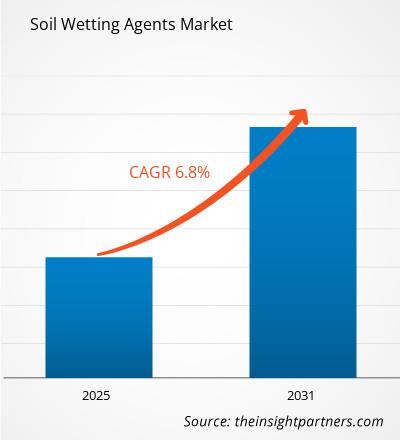Der Markt für Bodenbenetzungsmittel wird voraussichtlich von 2024 bis 2031 eine durchschnittliche jährliche Wachstumsrate (CAGR) von 6,8 % verzeichnen, wobei die Marktgröße von XX Millionen US-Dollar im Jahr 2024 auf XX Millionen US-Dollar im Jahr 2031 wachsen wird.
Der Bericht ist nach Form (flüssig und körnig) segmentiert. Der Bericht ist weiter nach Anwendung (Rasenpflege und Landwirtschaft) segmentiert. Der Bericht präsentiert außerdem eine Analyse basierend auf den Endverbrauchsprodukten (Insektizide, Pestizide, Fungizide und Düngemittel). Der Berichtsumfang umfasst fünf Regionen: Nordamerika, Europa, Asien-Pazifik, Naher Osten und Afrika sowie Süd- und Mittelamerika und Schlüsselländer in jeder Region. Die globale Analyse ist weiter auf regionaler Ebene und in den wichtigsten Ländern aufgeschlüsselt. Der Bericht bietet den Wert in USD für die oben genannte Analyse und Segmente.
Zweck des Berichts
Der Bericht „Markt für Bodenbenetzungsmittel“ von The Insight Partners soll die aktuelle Situation und das zukünftige Wachstum sowie die wichtigsten treibenden Faktoren, Herausforderungen und Chancen beschreiben. Dies wird verschiedenen Geschäftspartnern Einblicke geben, wie zum Beispiel:
- Technologieanbieter/-hersteller: Um die sich entwickelnde Marktdynamik zu verstehen und die potenziellen Wachstumschancen zu kennen, damit sie fundierte strategische Entscheidungen treffen können.
- Investoren: Durchführung einer umfassenden Trendanalyse hinsichtlich der Marktwachstumsrate, der finanziellen Marktprognosen und der Chancen entlang der Wertschöpfungskette.
- Regulierungsbehörden: Zur Regulierung von Richtlinien und Überwachungsaktivitäten auf dem Markt mit dem Ziel, Missbrauch zu minimieren, das Vertrauen der Anleger zu bewahren und die Integrität und Stabilität des Marktes aufrechtzuerhalten.
Bodenbenetzungsmittel Marktsegmentierung
Bilden
- Flüssig und körnig
Anwendung
- Rasenpflege und Landwirtschaft
Endverbrauchsprodukte
- Insektizide
- Pestizide
- Fungizide
- Düngemittel
Geographie
- Nordamerika
- Europa
- Asien-Pazifik
- Süd- und Mittelamerika
- Naher Osten und Afrika
Passen Sie diesen Bericht Ihren Anforderungen an
Sie erhalten kostenlos individuelle Anpassungen an jedem Bericht, einschließlich Teilen dieses Berichts oder einer Analyse auf Länderebene, eines Excel-Datenpakets sowie tolle Angebote und Rabatte für Start-ups und Universitäten.
- Holen Sie sich die wichtigsten Markttrends aus diesem Bericht.Dieses KOSTENLOSE Beispiel umfasst eine Datenanalyse von Markttrends bis hin zu Schätzungen und Prognosen.
Wachstumstreiber auf dem Markt für Bodenbenetzungsmittel
- Erhöhte Nachfrage nach effizienter Wassernutzung in Landwirtschaft und Landschaftsbau: Der steigende Wasserbedarf hat die Anforderungen an eine effiziente Wassernutzung in Landwirtschaft und Landschaftsbau erhöht. Bodenbenetzungsmittel verbessern die Wasserspeicherung im Boden, erhöhen die Infiltrationsrate und reduzieren Abflusswasser. Daher sind sie ein äußerst wertvolles Material für den Einsatz in trockenen Gebieten oder Gebieten mit knappen Wasserressourcen. Sie sind ein wichtiger Bestandteil der Wassereinsparung in Landwirtschaft, Rasenpflege und Gartenbau, da sie die Wassernutzungseffizienz maximieren können, indem sie eine bessere Feuchtigkeitsverteilung und -speicherung gewährleisten.
- Ausrichtung an nachhaltigen landwirtschaftlichen Praktiken: Der Trend zur nachhaltigen Landwirtschaft hat den Einsatz von Bodenbenetzungsmitteln beschleunigt. Sie sind nützliche Produkte zur Korrektur von Hydrophobie – wasserabweisenden Böden –, bei denen geringere Ernteerträge mit verringertem Pflanzenwachstum einhergehen können. Die Bodenbenetzungsmittel fördern das Wurzelwachstum, verbessern die Nährstoffaufnahme und unterstützen die Bodengesundheit. Diese Mittel entsprechen den Zielen einer nachhaltigen Landwirtschaft, indem sie die Wasserspeicherkapazität landwirtschaftlicher Flächen verbessern und gleichzeitig den Bewässerungsbedarf minimieren. Auf diese Weise wird Wasser gespart, die Ernteerträge maximiert und die zerstörerischen Auswirkungen der Landwirte auf die Umwelt minimiert.
- Auswirkungen des Klimawandels auf Bodenfeuchtigkeit und Wetterextreme: Der Klimawandel hat zu häufigeren und intensiveren Wetterereignissen wie Dürren und starken Regenfällen geführt. Solche Chemikalien können in trockenen oder halbtrockenen Gebieten eingesetzt werden, um den Feuchtigkeitsgehalt des Bodens durch Benetzungsmittel aufrechtzuerhalten und dann die negativen Auswirkungen von Wasserstress auf die Ernte auszugleichen. An Orten mit starken Regenfällen erhöhen solche Mittel das Eindringen von Wasser in die Oberfläche und verringern den Oberflächenabfluss. Zunehmend unvorhersehbare Klimabedingungen erfordern den Einsatz von Produkten, die die Speicherung von Bodenwasser und die Widerstandsfähigkeit gegen extreme Wetterbedingungen verbessern, was hauptsächlich die Nachfrage nach Bodenbenetzungsmitteln erhöht hat.
Markttrends für Bodenbenetzungsmittel
- Steigende Nachfrage nach organischen und biologisch abbaubaren Bodenbenetzungsmitteln: Da die Verbraucher zunehmend organische und umweltfreundliche Alternativen verlangen, wächst der Markt für natürliche und biologisch abbaubare Bodenbenetzungsmittel. Organische Bodenbenetzungsmittel auf pflanzlicher oder ungiftiger Basis erfreuen sich in der Landwirtschaft und im Gartenbau zunehmender Beliebtheit. Diese Produkte bieten nachhaltige Lösungen für das Wassermanagement, die die Umwelt nicht schädigen, was sie für Landwirte, Gärtner und Rasenpfleger, die nach Alternativen zu herkömmlichen chemischen Produkten suchen, relativ attraktiv macht.
- Innovationen bei Formulierungen und Technologien für Bodenbenetzungsmittel: Zu den fortschrittlichen Entwicklungen gehören verbesserte Formulierungen von Benetzungsmitteln, die effizienter, langlebiger und wirksamer sind. Neuere Formulierungen kombinieren Benetzungsmittel mit anderen Zusatzstoffen wie Bodenverbesserern, Düngemitteln und Nährstoffen, um eine umfassende Lösung für die Bodengesundheit zu bieten. Innovationen bei Verkapselungstechnologien haben die Leistung verbessert und so mehr Kosten gespart und eine Anwendung in geringerer Häufigkeit ermöglicht, da die Menge der freigesetzten Benetzungsmittel über einen längeren Zeitraum verteilt wird.
- Präzisionslandwirtschaft und Bodenbenetzungsmittel: Die Verwendung von Bodenbenetzungsmitteln nimmt im Zuge der Entwicklung der Präzisionslandwirtschaft zu, die durch Technologien wie Sensoren, Drohnen und Satellitenkartierung unterstützt wird. Präzisionslandwirtschaft bezeichnet die Verbesserung der Ernteerträge durch Manager und Landwirte, die die Bodenfeuchtigkeit mithilfe fortschrittlicher Technologie in kürzester Zeit überwachen können. Sie verbessert die Ressourceneffizienz, indem die maximale Wassermenge zum richtigen Zeitpunkt ausgebracht und der übermäßige Einsatz von Chemikalien richtig gesteuert wird, wodurch die Umweltverschmutzung verringert wird. Dies ist in die Praktiken der Präzisionslandwirtschaft integriert, zusammen mit dem breiteren Trend zu datengesteuerter nachhaltiger Landwirtschaft.
Marktchancen für Bodenbenetzungsmittel
- Wachsendes Marktpotenzial in Entwicklungsregionen: Da die Landwirtschaft in Entwicklungsregionen wie Afrika, Südostasien und Lateinamerika immer intensiver wird, ergeben sich spannende Aussichten für den Einsatz von Bodenbenetzungsmitteln. Schlechtes Wassermanagement und Bodenerosion stehen in allen genannten Bereichen an der Spitze der regionalen Probleme; Bodenbenetzungsmittel tragen insbesondere zur Verbesserung der Wasserspeicherung im Boden sowie zur Steigerung der Ernteproduktivität bei. Die Einführung dieser Produkte in Schwellenmärkten, insbesondere in von Dürre oder unregelmäßigen und saisonalen Niederschlagsmustern betroffenen Gebieten, birgt für die Hersteller großes Expansionspotenzial.
- Urban Gardening und Entwicklung von Grünflächen: Bodenbenetzungsmittel könnten durch den Ausbau des Urban Gardening und die Vergrößerung der Grünflächen in Wohn- und Gewerbegebieten in städtischen Gebieten neue Chancen erhalten. Benetzungsmittel können dazu beitragen, die Feuchtigkeitsspeicherung des Bodens und die Pflanzengesundheit in städtischen Umgebungen zu verbessern, da die Bodenqualität in diesen Gebieten normalerweise gering ist und Wassereinsparung von großer Bedeutung ist. Das größere Interesse an nachhaltiger Stadtlandschaftsgestaltung und Gründächern, Gemeinschaftsgärten und dürretoleranter Landschaftsgestaltung eröffnet neue Marktchancen für Bodenbenetzungsmittel sowohl im städtischen als auch im vorstädtischen Markt.
- Anpassung an den Klimawandel und Widerstandsfähigkeit: Da der Klimawandel das globale Wetter verändert, werden Bodenbenetzungsmittel zunehmend als Teil umfassender Strategien zur Widerstandsfähigkeit gegenüber dem Klimawandel eingesetzt. Produkte zur Dürreminderung, Bodenerosionsminderung und Wassereinsparung sind sehr gefragt. Bodenschutztechniken werden von Regierungen, Landwirtschaftsbehörden und Umweltorganisationen verfolgt, was Möglichkeiten für Bodenbenetzungsmittel in Klimaanpassungs- und Wassermanagementprogrammen eröffnet. Da die Politik und die Finanzierung in Bezug auf Klimawandel, nachhaltige Landwirtschaft und Landnutzungsmanagement zunehmen, werden Bodenbenetzungsmittel wahrscheinlich in einer besseren Position für eine stärkere Nutzung in der Landwirtschaft und im Landschaftsbau sein.
Regionale Einblicke in den Markt für Bodenbenetzungsmittel
Die regionalen Trends und Faktoren, die den Markt für Bodenbenetzungsmittel im Prognosezeitraum beeinflussen, wurden von den Analysten von Insight Partners ausführlich erläutert. In diesem Abschnitt werden auch die Marktsegmente und die Geografie von Bodenbenetzungsmitteln in Nordamerika, Europa, im asiatisch-pazifischen Raum, im Nahen Osten und Afrika sowie in Süd- und Mittelamerika erörtert.

- Erhalten Sie regionale Daten zum Markt für Bodenbenetzungsmittel
Umfang des Marktberichts zu Bodenbenetzungsmitteln
| Berichtsattribut | Details |
|---|---|
| Marktgröße im Jahr 2024 | XX Millionen US-Dollar |
| Marktgröße bis 2031 | XX Millionen US-Dollar |
| Globale CAGR (2025 - 2031) | 6,8 % |
| Historische Daten | 2021-2023 |
| Prognosezeitraum | 2025–2031 |
| Abgedeckte Segmente | Nach Formular
|
| Abgedeckte Regionen und Länder | Nordamerika
|
| Marktführer und wichtige Unternehmensprofile |
|
Dichte der Marktteilnehmer für Bodenbenetzungsmittel: Auswirkungen auf die Geschäftsdynamik verstehen
Der Markt für Bodenbenetzungsmittel wächst rasant, angetrieben durch die steigende Nachfrage der Endverbraucher aufgrund von Faktoren wie sich entwickelnden Verbraucherpräferenzen, technologischen Fortschritten und einem größeren Bewusstsein für die Vorteile des Produkts. Mit steigender Nachfrage erweitern Unternehmen ihr Angebot, entwickeln Innovationen, um die Bedürfnisse der Verbraucher zu erfüllen, und nutzen neue Trends, was das Marktwachstum weiter ankurbelt.
Die Marktteilnehmerdichte bezieht sich auf die Verteilung der Firmen oder Unternehmen, die in einem bestimmten Markt oder einer bestimmten Branche tätig sind. Sie gibt an, wie viele Wettbewerber (Marktteilnehmer) in einem bestimmten Marktraum im Verhältnis zu seiner Größe oder seinem gesamten Marktwert präsent sind.
Die wichtigsten auf dem Markt für Bodenbenetzungsmittel tätigen Unternehmen sind:
- ADS Agrotech Pvt. GmbH.
- BASF SE
- BRETTYOUNG
- Geoponics Corp
- Grow More Inc
Haftungsausschluss : Die oben aufgeführten Unternehmen sind nicht in einer bestimmten Reihenfolge aufgeführt.

- Überblick über die wichtigsten Akteure auf dem Markt für Bodenbenetzungsmittel
Wichtige Verkaufsargumente
- Umfassende Abdeckung: Der Bericht deckt die Analyse von Produkten, Dienstleistungen, Typen und Endbenutzern des Bodenbenetzungsmittel-Marktes umfassend ab und bietet einen ganzheitlichen Überblick.
- Expertenanalyse: Der Bericht basiert auf dem umfassenden Verständnis von Branchenexperten und Analysten.
- Aktuelle Informationen: Der Bericht stellt durch die Abdeckung aktueller Informationen und Datentrends Geschäftsrelevanz sicher.
- Anpassungsoptionen: Dieser Bericht kann angepasst werden, um spezifische Kundenanforderungen zu erfüllen und die Geschäftsstrategien optimal anzupassen.
Der Forschungsbericht zum Markt für Bodenbenetzungsmittel kann daher dabei helfen, die Branchensituation und Wachstumsaussichten zu entschlüsseln und zu verstehen. Obwohl es einige berechtigte Bedenken geben kann, überwiegen die allgemeinen Vorteile dieses Berichts tendenziell die Nachteile.
- Historische Analyse (2 Jahre), Basisjahr, Prognose (7 Jahre) mit CAGR
- PEST- und SWOT-Analyse
- Marktgröße Wert/Volumen – Global, Regional, Land
- Branche und Wettbewerbsumfeld
- Excel-Datensatz



Report Coverage
Revenue forecast, Company Analysis, Industry landscape, Growth factors, and Trends

Segment Covered
This text is related
to segments covered.

Regional Scope
North America, Europe, Asia Pacific, Middle East & Africa, South & Central America

Country Scope
This text is related
to country scope.
Häufig gestellte Fragen
Growth in organic and eco-friendly products is expected to be the key market trend.
The report can be delivered in PDF/Word format, we can also share excel data sheet based on request.
On the basis of geography, the soil wetting agents market is classified into North America, Europe, Asia Pacific, Middle East and Africa, and South and Central America
Grow More Inc, Nufarm Canada, Milliken & Co, Geoponics Corp, BASF SE, Wilbur-Ellis Holdings Inc, ADS Agrotech Pvt Ltd, Chinadrip Irrigation Equipment Co Ltd, Iota Silicone Oil (Anhui) Co Ltd, and MD BIOCOALS Pvt Ltd
The major factors driving the soil wetting agents market are:
1. Increasing Water Scarcity and Demand for Efficient Water Use.
2. Rising Adoption of Sustainable Agricultural Practices.
The Soil Wetting Agents Market is estimated to witness a CAGR of 6.8% from 2023 to 2031
Trends and growth analysis reports related to Chemicals and Materials : READ MORE..
1. ADS Agrotech Pvt. Ltd.
2. BASF SE
3. BRETTYOUNG
4. Geoponics Corp
5. Grow More Inc
6. MD Biocoals Pvt. Ltd.
7. Milliken and Company
8. Nufarm Malaysia Sdn Bhd
9. Seasol
10. SUDARSHAN ORGANICS PVT. LTD.
The Insight Partners performs research in 4 major stages: Data Collection & Secondary Research, Primary Research, Data Analysis and Data Triangulation & Final Review.
- Data Collection and Secondary Research:
As a market research and consulting firm operating from a decade, we have published and advised several client across the globe. First step for any study will start with an assessment of currently available data and insights from existing reports. Further, historical and current market information is collected from Investor Presentations, Annual Reports, SEC Filings, etc., and other information related to company’s performance and market positioning are gathered from Paid Databases (Factiva, Hoovers, and Reuters) and various other publications available in public domain.
Several associations trade associates, technical forums, institutes, societies and organization are accessed to gain technical as well as market related insights through their publications such as research papers, blogs and press releases related to the studies are referred to get cues about the market. Further, white papers, journals, magazines, and other news articles published in last 3 years are scrutinized and analyzed to understand the current market trends.
- Primary Research:
The primarily interview analysis comprise of data obtained from industry participants interview and answers to survey questions gathered by in-house primary team.
For primary research, interviews are conducted with industry experts/CEOs/Marketing Managers/VPs/Subject Matter Experts from both demand and supply side to get a 360-degree view of the market. The primary team conducts several interviews based on the complexity of the markets to understand the various market trends and dynamics which makes research more credible and precise.
A typical research interview fulfils the following functions:
- Provides first-hand information on the market size, market trends, growth trends, competitive landscape, and outlook
- Validates and strengthens in-house secondary research findings
- Develops the analysis team’s expertise and market understanding
Primary research involves email interactions and telephone interviews for each market, category, segment, and sub-segment across geographies. The participants who typically take part in such a process include, but are not limited to:
- Industry participants: VPs, business development managers, market intelligence managers and national sales managers
- Outside experts: Valuation experts, research analysts and key opinion leaders specializing in the electronics and semiconductor industry.
Below is the breakup of our primary respondents by company, designation, and region:

Once we receive the confirmation from primary research sources or primary respondents, we finalize the base year market estimation and forecast the data as per the macroeconomic and microeconomic factors assessed during data collection.
- Data Analysis:
Once data is validated through both secondary as well as primary respondents, we finalize the market estimations by hypothesis formulation and factor analysis at regional and country level.
- Macro-Economic Factor Analysis:
We analyse macroeconomic indicators such the gross domestic product (GDP), increase in the demand for goods and services across industries, technological advancement, regional economic growth, governmental policies, the influence of COVID-19, PEST analysis, and other aspects. This analysis aids in setting benchmarks for various nations/regions and approximating market splits. Additionally, the general trend of the aforementioned components aid in determining the market's development possibilities.
- Country Level Data:
Various factors that are especially aligned to the country are taken into account to determine the market size for a certain area and country, including the presence of vendors, such as headquarters and offices, the country's GDP, demand patterns, and industry growth. To comprehend the market dynamics for the nation, a number of growth variables, inhibitors, application areas, and current market trends are researched. The aforementioned elements aid in determining the country's overall market's growth potential.
- Company Profile:
The “Table of Contents” is formulated by listing and analyzing more than 25 - 30 companies operating in the market ecosystem across geographies. However, we profile only 10 companies as a standard practice in our syndicate reports. These 10 companies comprise leading, emerging, and regional players. Nonetheless, our analysis is not restricted to the 10 listed companies, we also analyze other companies present in the market to develop a holistic view and understand the prevailing trends. The “Company Profiles” section in the report covers key facts, business description, products & services, financial information, SWOT analysis, and key developments. The financial information presented is extracted from the annual reports and official documents of the publicly listed companies. Upon collecting the information for the sections of respective companies, we verify them via various primary sources and then compile the data in respective company profiles. The company level information helps us in deriving the base number as well as in forecasting the market size.
- Developing Base Number:
Aggregation of sales statistics (2020-2022) and macro-economic factor, and other secondary and primary research insights are utilized to arrive at base number and related market shares for 2022. The data gaps are identified in this step and relevant market data is analyzed, collected from paid primary interviews or databases. On finalizing the base year market size, forecasts are developed on the basis of macro-economic, industry and market growth factors and company level analysis.
- Data Triangulation and Final Review:
The market findings and base year market size calculations are validated from supply as well as demand side. Demand side validations are based on macro-economic factor analysis and benchmarks for respective regions and countries. In case of supply side validations, revenues of major companies are estimated (in case not available) based on industry benchmark, approximate number of employees, product portfolio, and primary interviews revenues are gathered. Further revenue from target product/service segment is assessed to avoid overshooting of market statistics. In case of heavy deviations between supply and demand side values, all thes steps are repeated to achieve synchronization.
We follow an iterative model, wherein we share our research findings with Subject Matter Experts (SME’s) and Key Opinion Leaders (KOLs) until consensus view of the market is not formulated – this model negates any drastic deviation in the opinions of experts. Only validated and universally acceptable research findings are quoted in our reports.
We have important check points that we use to validate our research findings – which we call – data triangulation, where we validate the information, we generate from secondary sources with primary interviews and then we re-validate with our internal data bases and Subject matter experts. This comprehensive model enables us to deliver high quality, reliable data in shortest possible time.


 Holen Sie sich ein kostenloses Muster für diesen Bericht
Holen Sie sich ein kostenloses Muster für diesen Bericht